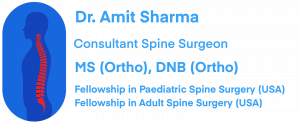Best Spine Surgeon in Mumbai | Dr. Amit Sharma

+91-9967600461
draks777@gmail.com
How is the recovery after spine surgery?

How is the recovery after spine surgery?
Recovery after Spine Surgery
In the current era, where understanding about spine problems is increased and latest technologies help a spine specialist perform spine surgeries in a safe and effective manner, recovery from spine surgery has become very smooth and predictable. Patients are allowed to sit and walk very next day after spine surgery (and in some cases even on same day). A minimally invasive spine surgery makes this rehabilitation even faster due to minimal pain and muscle damage. Even after a traditional spine surgery, patient can mobilize as early as next day. Discharge from the hospital is usually within 2-3 days after the surgery; however, certain minimally invasive spine surgeries (e.g. discectomy, spinal canal decompression and cervical spine surgery) can be done as day care spine surgery procedure also.
At home, patients are encouraged to do their routine day-to-day activities. Though certain restrictions are recommended on case to case basis, e.g. no sitting on floor, lifting heavy weights, bending etc., patient can perform most of their daily routine with ease. Patient can attend office in as early as 3-4 days after a minimally invasive spine surgery. Gym and sports activities are usually allowed only after six months, to prevent recurrence of problem after spinal decompression surgeries and to allow solid bone healing for spine instrumentation/ fusion surgeries.
Recovery after spine surgery depends on many factors
- Type of spine problem
- Severity and duration of spine problem
- Type of spine surgery
- Type of work patient does
Type of spine problem: A person suffering from minor spine problem (e.g. slip disc, spine stenosis, cervical disc) usually recovers faster as the amount of surgery required for these kind of spine problem is minimal. In majority of the cases patients are able to sit and walk on the day of surgery or next day with minimal pain. On the other hand, if a patient is suffering from spine fracture, scoliosis, spine infection etc., which requires a major spine surgery, patient might be advised few days of bed rest. Though, with the recent advances in spine surgery, even after these major spine surgeries, most of the patients can sit and walk in 2-3 days.
Severity and duration of spine problem: Severe and long standing symptoms usually take longer to recover. Many patients present with foot drop, paralysis or severe weakness in hands. In these patients, even after a well-executed surgery with adequate nerve decompression, recovery might take long time from existing weakness as damaged nerve gradually restore its functions. In some cases, a full recovery may not be achieved due to permanent damage to spinal nerve/ spinal cord. Long standing problems also create muscle weakness due to inactivity and this leads to slow rehabilitation. Also, person suffering from severe pain since long develop psychological issues due to pain and loss of active life/ work.
Type of spine surgery: A patient undergoing single level discectomy or spinal stenosis decompression surgery will have a quicker recovery compared to a patient who undergoes a spine instrumentation/ fusion surgery for the same problem. However, sometimes it is preferable to do a bigger surgery, even though it might require 1-2 days of additional stay in hospital, to take care of certain aspect of patient symptoms and to prevent recurrence of problem at same level. A spine instrumentation/ fusion surgery will require more care and precautions from patient to let instrumented spinal level heal.
Type of Occupation: A person involved in a desk job is able to return back to his work earlier compared to a patient who is involved in heavy manual labour activities. Also, a person involved in heavy activities has more chance to develop progressive degeneration of the spinal tissue and hence in these patients a spine fusion surgery is usually preferred compared to only spine decompression to prevent recurrent symptoms at same level. This leads to longer recovery period. For certain activities, e.g. lifting very heavy weight, sports and gym activities etc., long term limitations are applicable to every patient.